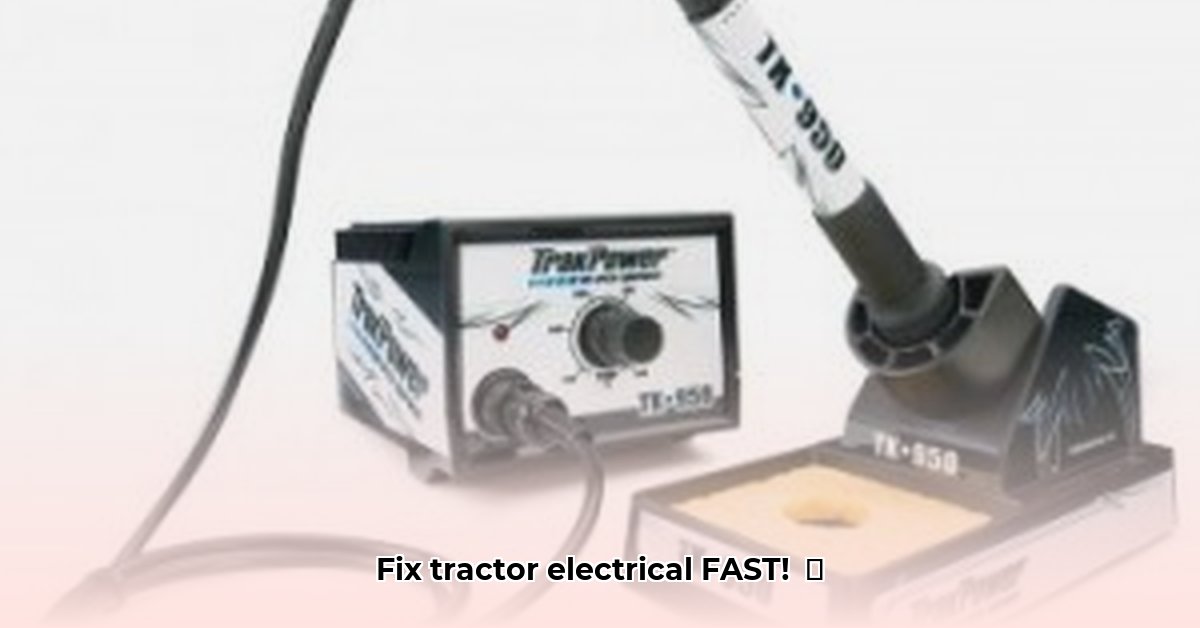
Choosing the Right Soldering Iron for Tractor Repair
Electrical problems on your tractor can be frustrating, but fixing them doesn't require a professional. A soldering iron, easily found at Tractor Supply, is often the solution. Choosing the right one, however, is key. What wattage do you need? A higher wattage (e.g., 40 watts) heats up faster, ideal for thicker wires. Lower wattage (around 25 watts) is better for delicate work. A 25-40 watt iron is versatile for many farm repairs. Tip size matters too; smaller tips are great for detail work, while larger tips handle thicker wires. Consider the size of the wires you typically work with when making your selection. Do you primarily need to work on thin or thick wires? This helps determine the optimal tip size. For more information on specialized soldering irons, check out this helpful resource: Tractor Supply Soldering Irons.
Safety Precautions: Protecting Yourself While Soldering
Safety is paramount when working with electricity and heat. Always work in a well-ventilated area to avoid inhaling soldering fumes. Safety glasses protect your eyes from sparks and molten solder. Heat-resistant gloves prevent burns. Never leave a hot soldering iron unattended; it's a serious fire hazard. Keep a fire extinguisher nearby for added safety. What's the biggest safety hazard you foresee when using a soldering iron? Ignoring the heat and fumes, of course! These are the most frequent causes of soldering accidents.
Gathering Your Supplies: Beyond the Soldering Iron
Besides the soldering iron, you'll need additional supplies:
- Rosin-core solder: This type of solder is designed for electrical work and ensures a strong, reliable connection.
- Solder wick (or braid): This tool removes excess solder, correcting mistakes.
- Helping hands (or a third hand): These clamps hold components in place during soldering.
- Wire strippers: Essential for cleanly stripping wire insulation without damaging the wire itself.
- Clean workspace: A clean, organized workspace minimizes accidents and makes the job easier. Is there a statistic on the impact of a clean workspace on repair time or accident rates? Research suggests a clean workspace significantly reduces repair time and errors.
Soldering 101: Step-by-Step Wire Repair
Let's repair a broken wire—a common tractor repair. This process applies to most tractor wiring repairs.
- Prepare the wires: Carefully strip about ½ inch of insulation from each wire end. Be gentle to avoid damaging the wire.
- Tinning the wires: Apply a small amount of solder to each exposed wire end. This improves the connection.
- Connecting the wires: Join the tinned wire ends, using helping hands to hold them securely.
- Applying the solder: Heat the joint with the soldering iron. Touch the rosin-core solder; it should flow smoothly.
- Inspect your work: The completed joint should be smooth, shiny, and solid. It should not move or be loose.
Troubleshooting Common Soldering Problems
Even experienced solderers encounter problems. Here's how to address common issues:
- Cold solder joint (dull, grainy): Insufficient heat. Reheat the joint and apply more solder.
- Too much solder: Use solder wick to remove the excess.
- Poor connection: Wires weren't clean or securely joined. Start again, ensuring cleanliness and secure connection. What percentage of soldering failures are attributed to poor preparation? A significant proportion of failed solder joints are due to poor wire preparation.
Maintaining Your Soldering Iron: Extending Its Life
Proper care extends your soldering iron's lifespan:
- Clean the tip regularly: Use a damp sponge or brass wool to remove residue.
- Store it properly: Store it upright in its stand, away from moisture and dust. Appropriate storage significantly reduces the chances of damage or premature wear.
Selecting the Right Soldering Iron for Your Needs
| Feature | Consideration |
|---|---|
| Wattage | 25-40 watts offers good versatility; higher wattage for thicker cables, lower for delicate electronics |
| Tip Size | Smaller tips for fine detail and smaller wires; larger tips for bigger cables |
| Temperature Control | Helpful for precise work, especially with delicate electronics. Often unnecessary for basic tractor repairs. |
| Tip Type | Chisel, conical, or knife tips; choose according to your typical tasks. |
With practice and the right tools, you can efficiently and safely fix your tractor's electrical issues. Remember, patience and attention to detail are key to successful soldering.